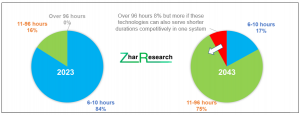5GRedCap, 6G and LDES March us to Battery-free Technology
LONDON, ENGLAND, UNITED KINGDOM, August 16, 2023/EINPresswire.com/ -- Battery-free technology is a megatrend. It already involves both elimination of energy storage and alternatives to batteries. It provides both a new competitive edge for system designers and a large new hardware market from electronics to heavy engineering. The full picture is in the Zhar Research2 Report, “Battery-free 6G Communications, IoT, Microgrids and Other Batteryless Technology Markets 2023-2043”.
Two views
Dr Peter Harrop, CEO of Zhar Research advises, “There are two ways of looking at batteryless technology. One is hundreds of billions of dollars that will be spent every year on equipment that abandons batteries because they are too expensive, cannot meet new requirements or become overkill. In fact, much of that batteryless equipment market will later involve no energy storage at all. The second approach is to look at alternative forms of energy storage running at tens of billions of dollars yearly from pseudocapacitors to pumped hydro. They will be needed far more in future due to the demands of e-skin up to clean grid power.”
5G RedCap arrives
Batteryless wireless equipment follows a sequence from passive RFID and anti-theft tags running at 20 billion units yearly with zero batteries to today’s hot topic, 5G RedCap. This a missing link alongside existing massive Machine Type Communication mMTC which offers ultra-low power consumption and enhanced in-building telecommunications coverage - useful for industrial monitoring and control, telematics, video surveillance, sensor networks and wearables. For IoT nodes, 5G RedCap will sometimes offer such low power consumption that a fit-and-forget supercapacitor will suffice instead of a battery. It is the new transition path to 5G for applications currently utilizing LTE Cat 1 or Cat 4 air interfaces with the first chipset this year. 3GPP Release 18 encompasses further evolution of 5G RedCap, targettting reduced complexity for completion in 2024. Unfortunately, considering network availability and chipsets after 3GPP publishes a new release, commercialisation may be in 2028 but by then 5G non-handset device market may have quadrupled to 140 million yearly on Zhar Research projections. Meanwhile, mobile network operators in the United States and some APAC countries will probably be the first to roll out 5G RedCap, prompting an earlier transition phase and an eventual lifecycle end for LTE networks. That is certainly a stake in the ground as we embrace the batteryless megatrend. For telecoms. the next is in 2035.
6G SWIPT
Around 2035, the second phase of planned 6G Communications will operate battery-less IoT nodes from newly-capable infrastructure because THz emissions will be amplified and focussed by so-called fully-active reconfigurable intelligent surfaces everywhere – or such is the dream. Call that Simultaneous Wireless Information and Power Transfer SWIPT, an advanced form of the backscatter principle used for batteryless RFID today and part of the justification for 6G Communications.
Batteryless grids and microgrids
In parallel, the next ten years and beyond will see large microgrids - for desalination, data centers, factories, mining and islands - and grids increasingly approach 100% solar and wind with many approaching 100% solar alone. That makes Long Duration Energy Storage LDES essential. At those levels, it must be capable of one month of storage and some seasonal storage but the good news is that most of the candidate technologies will deliver electricity with response fast enough to cover load changes through the day as well, so no need for batteries alongside. No need for batteries at all by choosing from a considerable list of options assessed and forecasted by Zhar Research, which identifies gaps in the market. One is LDES for your solar house.
Right now, there is a massive rush into lithium-ion batteries but, probably between 2035 and 2040, their use in stationary energy storage will shrink as fast as it came because they will never viably perform LDES at the duration and capacity needed when solar, in particular, takes over electricity generation due to lower cost in most regions. However, it is true that there will be an interim window of opportunity for batteries such as iron-air and iron redox flow if they are found to be the most competitive for grids and microgrids with around 50% wind and solar needing only days of storage. History is repeated because such battery reinvention then rejection happened with almost all RFID 50 years ago.
You could put an (enormous) figure on the market for the battery-less grids and microgrids that will appear later. It will be boosted by any adoption of green power that is minimally intermittent such as wave and tidal energy and Airborne Wind Energy AWE from tethered kites and drones flying higher, where the wind is almost continuous. Fit-and-forget supercapacitors are sometimes adequate for all three options even now.
Better battery replacements
Battery alternatives include supercapacitors, pseudocapacitors and the Musashi lithium-ion capacitors adopted this year for the giant tokamak device at Kyushu University and Toyota Energy Solutions fuel cell generators. Other suppliers put them in electric trains and uninterruptible power supplies. Add flywheels for truck and trackside train regenerative braking but the longer duration superconducting versions do not impress Zhar Research. For those grids and large microgrids, we must include delayed electricity from stored compressed air, liquid air, carbon dioxide and pumped hydro. Hydrostor, Highview Power and others have full orderbooks for the beautifully clean “air” options. Zhar Research also advises a close watch on the more widely-deployable variants of pumped hydro being developed.
Large market becoming much larger
A rapidly-growing battery alternatives market emerges of tens of billions of dollars yearly even as Zhar Research downgrades the questionable calculations for delayed grid and microgrid electricity from stored hydrogen, other chemicals and thermal energy.
The forecasts, roadmaps and analysis are in unique report, “Battery-free 6G Communications, IoT, Microgrids and Other Batteryless Technology Markets 2023-2043”.
Dr Peter Harrop
Zhar Research
+44 7850 258317
email us here
Visit us on social media:
LinkedIn
1 https://www.zharresearch.com/shop/p/battery-free-6g-communications-iot
2 https://www.zharresearch.com/

